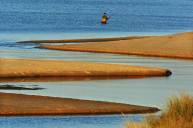Have you ever fished the St. Lawrence River? After reading this you'll want to.
The St. Lawrence River is one of the most iconic bodies of water in the United States and Canada. It borders parts of New York State, Ontario Canada, and connects the Great Lakes all the way to the ocean through Quebec and the Canadian Maritimes.
This river system is one of the largest in the world, and is responsible for draining more than a quarter of the world's freshwater reserves from the North American continent to its conclusion in the Atlantic Ocean.
It flows roughly northeast from its beginnings at the Tibbetts Point lighthouse in Cape Vincent, New York into the Gulf of St. Lawrence. This river is massive in its size and water flow, making even the mighty Mississippi pale in comparison. However, it still manages to fly somewhat under the radar as a great American fishery. Which is a shame considering the size of the fish it grows and the diversity of species found swimming within it. Let's just examine the angling opportunities offered by the St. Lawrence.
St. Lawrence River Fishing
Let's look at a quick overview of the gamefish species present in the big river. Most of our favorite gamefish are here, along with some others that are maybe not as popular.
- Largemouth Bass
- Smallmouth Bass
- Northern Pike
- Muskellunge
- Walleye
- Crappie
- Catfish
- Bullhead
The St. Lawrence also plays host to all the salmonids present in Lake Ontario including Chinook salmon, Coho salmon, rainbow trout, brown trout, and lake trout. There are also good populations of sturgeon, gar, freshwater drum, yellow perch, and other panfish. There's also a healthy population of common carp. Simply put, there should be at least one species on that list that will catch almost any angler's attention.
Of course, we're not saying the fishing is easy. After all, with an average width of two miles and a maximum depth of over 200 feet, this amazing natural outlet for the Great Lakes is the largest east-west running river in North America so finding fish can be a little daunting at first.
The area that starts near Cape Vincent and runs to approximately Morristown is the most popular area, and is known as the Thousand Islands Region. Fishing in the St. Lawrence, although as large as it is, can be a very family friendly experience for those who know it well, and as easy as finding a good charter service to learn its intricacies for those who are visiting for the first time.
One of the most interesting things about fishing the St. Lawrence Seaway is the fact that it borders so closely to Canada and the fact that you may find yourself fishing right next to ocean-going freighters the size of a skyscraper.
Bassmasters come here every single year to host some of their finest bass pros and put on tournaments that make all the others look insignificant. And there have been some seriously heavy limits of fish caught here over the years. In 1980, the river hosted the Super Bowl of bass fishing, the Bassmaster Classic, which was won by Bo Dowden with a total weight of 54 pounds, 10 ounces. An impressive total for a northern state where bass normally don't grow as large. Just about every year the Bassmaster Elite Series also makes a stop on this fabled fishing destination. In more recent years Major League Fishing has held tournaments here too. All because the bass fishing is second to none.
While largemouth bass are ever present in the river's shallow weedy bays and along edges of shoals, it is the stunning smallmouth fishery that makes this area king. Smallies seem to exist everywhere on the river and finding them takes some work during the summer conditions, but the results can be incredible. In 2016, the river produced an 8-pound, 4-ounce beast of a smallmouth that looked like it had swallowed a basketball thanks to its enormous girth. It's currently the New York State record.
Islands, points, and bays account for much of the take, but be on the lookout for submerged shoals and any underwater weeds that have some rocks adjacent to them.
Northern pike are a staple of the big river, but the only trouble is they love to munch all of our favorite bass baits and in the same locations. During the spring months, shallow weedy bays and shoals provide great action and then the fish spread out into the deeper areas for the summer.
As far as walleye fishing goes, with the right guide, location, and time of year anglers can hook up to some giants! The St. Lawrence River is full of huge marble eyes, not those skinny fish you can catch for a nice shore lunch. Once, I chartered my friend's guide service out of Cape Vincent in September and we landed 11 walleyes; only one was less than 10 pounds, and that one came to the scale at nine!
There is panfishing galore for those that love to dip a worm, or better yet, live minnows. Even ice fishermen fill buckets regularly with great catches of yellow perch, rock bass, crappie, bluegills, and pumpkinseeds.
Did we mention the muskie fishing yet? The St. Lawrence Seaway is not only a great muskellunge fishery, it is one of the best worldwide. This may be one of the best places on earth to catch a trophy 'lunge that can and will tip the scales at over 40 pounds.
In 1957, the New York State record 69 pound 15-ounce muskellunge was taken near Clayton and the record still stands today. It is steeped in some mystery and to this day is considered a bit controversial. However, the fact remains that huge muskies are taken each year by reputable guide service's clients, especially in October and November.
Accessing the St. Lawrence River
There are state parks and municipal (public) boat launching sites from Cape Vincent to Ogdensburg and more for the ready-to-go fishing crowd. Towns such as Clayton, Alexandria Bay, Goose Bay, Chippewa Bay, Oak Point, and Morristown are all locations where boating and camping enthusiasts can find exactly what they need to access and fish the river. State Parks that have their own boat launches include Burnham Point, Cedar Point, Wellesley Island, Keewaydin, Grass Point, and Kring Point just to name a few. You can find the entire list, fishing options, and much more on the NYS DEC website.
The DEC is quite adamant in reminding those new to the area that, "Boat anglers should keep in mind that this river is a part of the Seaway where large vessels frequent the shipping channel. Small boats should be alert to the potential hazards from these vessels and their wakes."
Honestly, the St. Lawrence, even as big as it is, is in relative close proximity to the Canadian border. This means that you will miss out on some of its best fishing opportunities unless you take the time to procure a Canadian sportfishing license.
The Last Word
When you begin to consider traveling to St. Lawrence County and the Thousand Islands to do some of the world's best angling, the first time that you lay eyes on the river you will be hooked. Great fishing is there to be had by all and the big river has stood the test of time.
To find the hot spots and have the best chance to be successful, consider hiring a reputable fishing guide to lead your expedition. At least until you gain some experience in finding where the fish are hiding. The St. Lawrence is a very large and daunting body of water and truly needs an experienced hand to show you the way. Otherwise you're in for a lot of searching, trial and error to figure out what works.
Big fish abound in the vast river region and those who know it best won't lead you astray, in fact they love to show everyone just how much the river means to them by proving that it is all that it's cracked up to be and more.
Looking for a new way to display those antler sheds? Go to Rack Hub and use the coupon code Craiger. Be sure to follow my webpage, or on Facebook and YouTube.
NEXT: HERE'S HOW YOU CAN BE A BASSMASTER MARSHAL
WATCH




